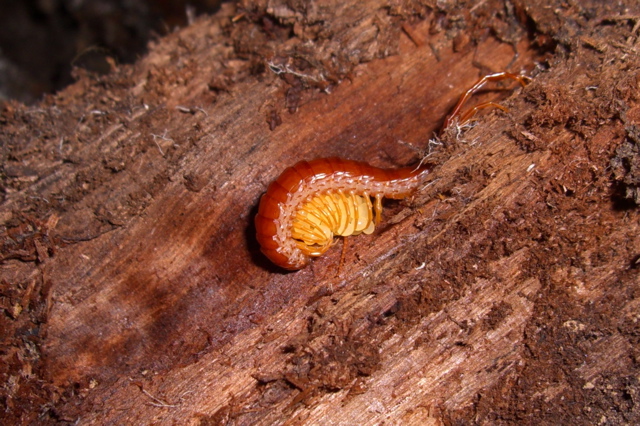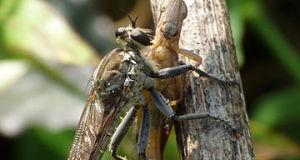 Please see Part 1 of this article for more on Giant Centipedes, Scolopendra gigantea, including escape stories and a video of a bat-hunting centipede in Trinidad.
Please see Part 1 of this article for more on Giant Centipedes, Scolopendra gigantea, including escape stories and a video of a bat-hunting centipede in Trinidad.
Centipede Diversity
Over 3,000 species, classified within the invertebrate order Chilopoda, have been identified to date. Many more will certainly come to light in time – several years ago a new centipede was discovered in the heart of New York City’s Central Park (please see article linked in Part 1). All, including the thinly-built and ubiquitous House Centipede (please see photo in Part 1), are capable of inflicting painful bites; fatalities, while unlikely, have occurred.
Centipedes have obviously hit upon a very successful survival strategy – as a group, they pre-date the dinosaurs, and have remained largely unchanged for over 400 million years.
Centipedes in Zoos
Those species that I’ve kept in zoo collections did best in exhibits that allowed for the creation of deep burrows. A thin exoskeleton and their inability to close off the spiracles renders centipedes prone to dehydration.
Natural history journals recount epic battles between centipedes and mice, tarantulas (please see video linked below), frogs, snakes and other hefty prey items, but captives fare well on a diet comprised of earthworms, crickets, roaches and other invertebrates.
In properly-designed displays under night-simulating lighting, centipedes are fascinating to observe, but they are not well-suited to private collections (please see below).
Centipedes in the Pet Trade
I do not recommend centipedes as pets, for reasons I’ll discuss in a moment. The centipedes available in the pet trade are most often members of the Genus Scolopendra. The commonly-imported Amazonian Giant Centipede, Scolopendra gigantea, is the world’s largest; the stoutly built females may top 12 inches in length. This venomous, ever-hungry brute has a wide range in Latin America and also occurs on several Caribbean Islands (but don’t look for its photo in any vacation travel brochures!).
Others that are sometimes kept by hobbyists include Eurasia’s Scolopendra cingulata and S. heros of the southern USA. However, identification is difficult even for specialists, and as many as 6 species have been sold under a single trade name (a fact which complicates the treatment of bites). Identification is further muddled by the vast array of colors – brown, gold, yellow, orange, purple, green – which individuals of a single species may exhibit.
Cautions: Life-Threatening Venom
 Centipede bites and escapes are common in captive situations…they are simply very difficult animals to deal with. Add to this the fact that we know little about the complex venoms and skin-irritating chemicals they produce, and you can see why these interesting creatures are best left to the care of professionals.
Centipede bites and escapes are common in captive situations…they are simply very difficult animals to deal with. Add to this the fact that we know little about the complex venoms and skin-irritating chemicals they produce, and you can see why these interesting creatures are best left to the care of professionals.
Bites from several species, including Giant Centipedes and others in the pet trade, have caused fevers, dizziness, cardiac problems and breathing difficulties, and fatalities have occurred; personal allergies are also a possibility (please see article below). A colleague of mine, bitten by an unidentified centipede in Brazil, lapsed into a coma and is fortunate to have survived.
As species identification and treatment are little-studied, keeping centipedes is a gamble not worth taking. By all means spend time watching them in public collections, but seek employment in a zoo if you wish practical experience. Please ignore the internet videos of people handling centipedes – promoting this is beyond irresponsible.
Further Reading
Discovery Video of a Giant Centipede catching and devouring a tarantula.
Centipede Bites (case studies).
Centipede image referenced from wikipedia and originally posted by Eric Guinther (Marshman)
Centipede protecting eggs image referenced from wikipedia and originally posted by Marshal Hedin
 That Reptile Blog – Reptile, Amphibian and Exotic Pet Care and Information
That Reptile Blog – Reptile, Amphibian and Exotic Pet Care and Information




Hi Frank
Do the centipedes only have poison in there fangs or do the have poison in the tiny tips at the end of their feet/legs as well?
Hello Gert, Frank Indiviglio here.
Thanks…interesting question. The main venom glands are just behind the mandibles/fangs. However, many species have smaller glands distributed throughout the body. These release toxins onto the exoskeleton, and they find their was onto the skin of attackers and cause irritations; the legs, especially the modified last pair, can sometimes break the skin, and toxins may enter in that way also. There are ove3r 3,000 species identified, many undiscovered, so I’m sure they have other types of glands as well – all-in-all, very formidable creatures!
Please let me know if you need any further information. Good luck, enjoy and please keep me posted.
Best regards, Frank Indiviglio.
I never knew that centipedes had fangs. This is a neat fact to learn!
Hello, Frank Indiviglio here.
Thanks for taking the time to write in; I used “fangs” as this is the most common term; technically, they are mandibles – modified mouthparts that are used for injecting toxins into their prey.
Please let me know if you need any further information. Good luck, enjoy and please keep me posted.
Best regards, Frank Indiviglio.
I saw a very large centipede in Antigua at the resort i was staying at. One night on the way back from the bar on one of the small walls along the path, my girlfriend at the time told me I should hold it, at which point I agreed if she picked it up for me(I watch enough nature shows to know these often get labeled as lions of the insect world). Since this thing had to be 10 inches long, much larger than the 2 inch ones here in New York that can still give a nasty bite, she smartly declined. A couple days later when recounting the tale to the woman who was our bartender earlier in the night of the encounter, I was shocked to hear her response of “you killed it right?” I explained I try not to go around snuffing out the life of the local flora and fauna of the countries I visit. I do understand her issue with them however. Apparently when she was about 12 years old she got bit ion the toe by one only half the size of the one I had seen and had a fever for about 3 days. This leads me to believe it’s not just the venom, but I would also guess there would be some pretty nasty bacteria on those big fangs as well to cause a fever that would last so long. She did not know anyone who died from them, but it is not all that uncommon for a nasty fever from a bite as many people walk around bare foot when they are kids.
Hello, Frank Indiviglio here.
Thanks for the most interesting observation…folks outside of the tropics usually do not realize what a serious problem centipedes can be. Unfortunately, they adapt well to human presence, indeed are often more common around dwellings than in natural habitats, and so must be controlled; People who are bitten at times when they are ill or at risk from other problems can be in serious danger.
We do not understand their venom well, less so than for snakes. Bacterial infection is a concern with any bite, but it’s difficult to say what effect it had in the case you mention. There is evidence that venom of certain snakes and other creatures may be more potent, on a drop-per-drop basis, in smaller individuals as compared to larger, because they cannot inject so much in a single bite; also, some venoms (blue ringed octopus, inland taipan, certain sea snakes and jellyfishes) are so powerful that a very tiny amount can cause a human fatality.
Please let me know if you need any further information.
Best regards, Frank Indiviglio.
After about 2 mins on google it appears the one I had come across was colopendra gigantea. I am so glad after watching a couple of youtube videos that the rum drinks I had the night of my encounter did not fog my judgement enough to make this nature boy decide to play with it.
Hello, Frank Indiviglio here.
Yes, lucky indeed – I’ve responded to a dozen or so venomous snakebite calls (mostly pets)…alcohol was involved in almost all!
Please let me know if you need any further information. Good luck, enjoy and please keep me posted.
Best regards, Frank Indiviglio.